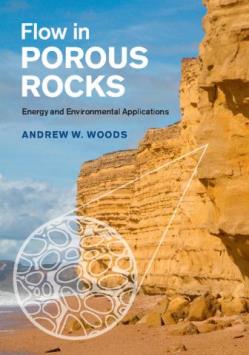Flow in Porous Rocks: Energy and Environmental Applications
 Andrew Woods has researched topics such as groundwater flow, contamination dispersion, oil recovery (primary, secondary and tertiary), underground nuclear waste disposal and geothermal recovery for over 25 years. Now he has shared his experience in 'Flow in porous rocks - energy and environmental applications' to introduce the physical processes of such flows through relevant geological formations supported by a series of analytical models.
Andrew Woods has researched topics such as groundwater flow, contamination dispersion, oil recovery (primary, secondary and tertiary), underground nuclear waste disposal and geothermal recovery for over 25 years. Now he has shared his experience in 'Flow in porous rocks - energy and environmental applications' to introduce the physical processes of such flows through relevant geological formations supported by a series of analytical models.
The book starts with an exposition of the challenges of modelling flow through porous geological bodies. Such structures are complex but Woods reduces the major features to layers and lenses with faults, sealing and/or non-sealing (leaking), usually arranged heterogeneously. By introducing reasonable assumptions, models that represent the key features which control the flow can be solved analytically to give clear demonstrations of what is going on. Woods' approach is to state the problem, create a model with relevant boundary conditions and then develop the final quantitative analytical solution. The mathematics is indicated but an undergraduate text in fluid mechanics might be needed. Sensitivity to uncertainty of geologic structures is a major challenge for estimating flow rates, so risk assessment and how to quantify are well discussed.
Woods uses these idealised models to elucidate the key controls on a range of systems. Thus applications giving physical insight into the processes are presented in chapters for the motion of oil-water two-phase flow, the stability of displacement fronts and fluid-rock interactions, gravity-driven upward flow movements, particularly the effects of baffles on pollution plumes of contaminants (including NAPL - non-aqueous-phase-liquids) with buoyancy, capillary trapping and dispersion. Finally recovery of energy from 'hot' rocks, geo-sequestration of CO2 and shale gas recovery are explored. He discusses the results and presents the information in figures covering the key dimensionless variables such as time, flowrate and strata thickness. These results can be applied practically, even informing management decisions. Many of the processes and models have been tested with laboratory experiments giving confidence in the modelling assumptions and analysis, pictures given.
End-of-chapter exercises allow the reader to develop the themes discussed, but solution guides could help. My copy of the book had text black-white figures but many were reproduced in a 30-page insert of coloured versions. Colour certainly highlights clearer many of the key points.
'Flow in porous rocks - energy and environmental applications' provides a helpful reference with many worked examples for energy systems in geological porous rocks using analytical models. It would assist computer modellers needing to understand/verify their simulation predictions, and graduate students and energy industry professionals needing a clear introduction.
Reviewed by Richard Dawe
Flow in Porous Rocks: Energy and Environmental Applications by Andrew W Woods. December 2014 Published by Cambridge University Press, 289pp Hardback ISBN: 9781107065857 List price £70.00 www.cambridge.org/9781107065857